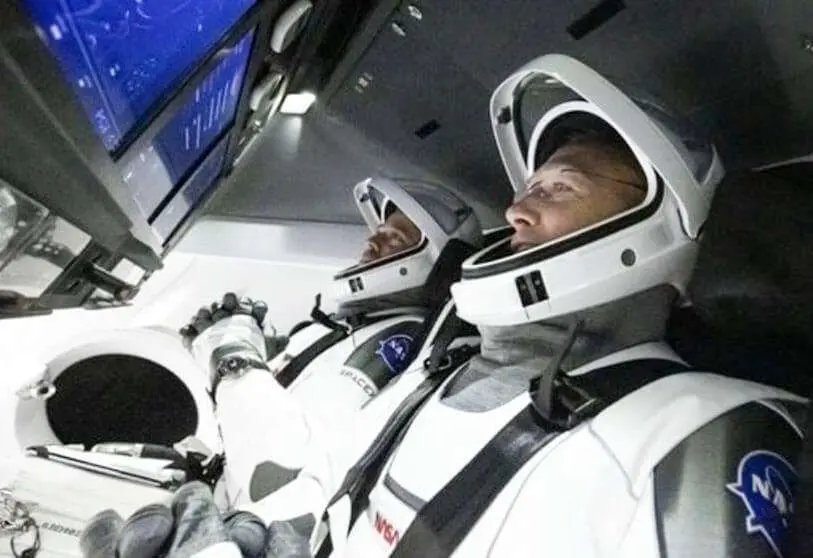Space X's new conquest of space

The stormy cores in the north of the Florida peninsula, capricious as always, have meant that the launch of the first manned space mission launched by NASA in eleven years has had to wait until this saturday. It is frequent to see in those Florida latitudes how the disturbances are formed throughout the day, and even on the clearest and sunniest days wind and rain storms appear that make one fear for the total destruction of the area. Many times it has happened, the inhabitants of the Cayos are well aware of the phenomenon. Astronauts Douglas Hurley and Robert Behnken had to get off the Crew Dragon spacecraft, powered by a Falcon-9 rocket, on their way to the International Space Station.
But the images that have been used by televisions around the world have opened a new stage in the conquest of space due to the new physiognomy of the elements used in the launch and in the flight, which until now had very different characteristics from those shown to us by Space X, the private company that sponsors the launch and which is twinned with the American space agency. These images refer in the subconscious to the space odyssey that Stanley Kubrick imagined in the 1960s in his film 2001.
Public-private cooperation, a reality in the world's leading power that in other countries is viewed with suspicion by significant social and political sectors, is thus experiencing a decisive boost in the United States: companies will pilot the launches into space of flying machines and crews, and the government will set the path for them to follow, and the launch platform at the Kennedy Space Center at Cape Canaveral. Cost reduction is an obsession of Elon Musk, the owner of the firm, who dreamed twenty years ago of something that these days is beginning to become a reality: a system of space buses that can transport humans to remote orbits, to colonize new planets or to face possible extinction on Earth.
The failed launch has left America with a sour taste in its mouth, it will be tried again this saturday, but it has allowed us to appreciate how the visual design of the conquest of space will change in the era when private companies take over from the all-powerful NASA. The image that we have been able to see of the interior of the ship is an important evolutionary leap with respect to the interiors that we knew of the Apollo series rockets or the most recent space agency shuttles. The controls in front of which Hurley and Behnkhen sat have nothing to do with what we knew until now at the command posts of the spaceships. No trace of the long tables full of activating buttons and monitors with graphics tracing lines and beeps constantly. Three simple touch screens, a tablet between the two astronauts, and a single lever for one-handed operation. The white suits with black shoulder pads and gloves are stripped of logos and stickers, out of all the imagery that NASA has always conferred on the clothing of its engineers. Everything reminds us of the images of 2001, a space odyssey.
What was Musk's inspiration for the space opera show that Kubrick created? The crew's costumes seem to have some connection with those of the stewardesses who serve the passengers on the journey to the space Hilton that awaits them millions of miles from home. Those outfits seemed to be more comfortable, within the unnaturalness of being locked in an airtight suit and weighing many kilos, something that Hurley and Behnkhen's suit designers seem to have looked for.
The control screen used in various rooms in the space inspired none other than Apple to design its Ipad, the device that revolutionised the tablet market. This was a creation of the German engineer Hans-Kurt Lange, on whom the New York director relied to give his film a futuristic and risky visual content. The film's astronaut Bowman can talk to his family from space thanks to the screen that is so familiar today, so much so that in the image that has been used for the frustrated launch an Ipad can be seen between the two astronauts. A wink to Stanley Kubrick or Tim Cook, but a wink indeed.
Equally minimalist is the rocket that will propel the capsule, whose upright silhouette in front of the structure of one of the shuttles differs greatly from the traditional shuttle structures of the recent space age, and is more reminiscent of the circular structures that dance the Blue Danube gently, suspended in the images and music of Kubrick's immortal work.
In the design of the large space operation conceived by Elon Musk, the client who is transported into space, to visit the Space Station or to spend a vacation at the outpost on the Moon or Mars, will have all the comforts on board, as in 2001. At the main entrance of the Kennedy Space Center there is a legend inscribed on one of the walls: "The sky calls to us", a phrase by Carl Sagan. Elon Musk has assimilated that message since he was a child, and thanks to his nonconformity and his ability to reinvent himself he is about to answer that call.

